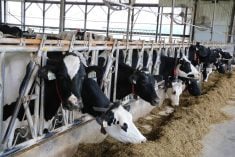Severe thunderstorms June 28 have left patches of western Manitoba fighting desperately to keep their heads above water.
Areas around Brandon, Rapid City and north towards Riding Mountain National Park reported widespread flooding June 28-29.
Brandon airport reported 155 millimetres of rain in a matter of hours, according to Environment and Climate Change Canada (ECCC), leaving the eastern entrance to the facility impassible and surrounding fields totally underwater.
Elsewhere, ECCC reported 156 millimetres in Oak River, 153 millimetres in Minnedosa, 120 millimetres in Alonsa, and 115 millimetres in Newdale.
Read Also

Finally getting paid for sustainable farming?
Alberta project says they might have a line on a workable ecosystem credit model to reward farmers for sustainability, and Manitoba might be next
“The rainfall was highly localized,” ECCC has said. “Only 19 mm was reported at a site 20 kilometres southeast of Brandon, while the city itself received over seven times that amount.”
In Oakburn, residents reported golf-ball sized hail while a “rain-wrapped tornado touched down briefly near Rapid City,” ECCC has said.
The Municipality of Oakview, which includes Rapid City, has announced a state of emergency in the wake of the storm. The region has reported snapped trees and property damage, as well as flooding.
Clayton Robins, who farms near Rivers, says his farm has been mercifully unharmed, despite about five inches of rain.
“Our ravines are running like crazy again and we’ve certainly gotten some ponding on our fields but, actually, the number of acres that look to be damaged is relatively small compared to what I saw on my way into work this morning, where whole fields are covered and huge chunks of land.”
Robins, who also works in Brandon, noted the challenge of navigating what he says is a sudden labyrinth of road closures and roads that have since turned into fords.
Water was still overflowing ditches and across many highways and rural roads as of the afternoon June 29, and widespread road closures were in effect. The TransCanada Highway directly east of Brandon was closed due to floodwaters June 29, while Highway 10 reported closures north of Forrest and again north of Minnedosa. Highway 25 between Highway 10 and Provincial Road 270, Provincial Road 270 from the TransCanada Highway to Rapid City, Highway 24 west of Rapid City and Highway 19 in Riding Mountain National Park are also reporting closures.
Rural roads fared little better.
“We had to turn around at least four different times,” Robins said. “We probably drove through some spots that we, maybe, in hindsight shouldn’t have tried. The water was going over the road, in some spots, at least once every mile.”
Those floodwaters may have since swelled, he noted, pointing to the topography of his region and rain that fell further to the north.
“There’s definitely a lot of water that’s laying and moving still all though this area and it’ll be a few days before a lot of this disappears, I think,” he said.
Northwest and Interlake
In the northwest and Interlake, rains were more welcome.
Apart from the 120 millimetres fallen over Alonsa, Ste. Rose du Lac reported about 30 millimetres, according to the province’s Ag weather network, while, closer to the Saskatchewan border, Inglis reported just over 15 millimetres.
Pam Iwanchysko, livestock specialist with the province based in the northwest, said rains near Roblin and Swan River were not enough to disperse the region’s previously dry conditions, although the area around Dauphin reported two to three inches.
The rain was, “needed for annual crops, so it was welcome,” she said.
The rain should help bolster the outlook for a second cut for hay growers, she said, although it will hinder first cut now.
Ray Bittner, Iwanchysko’s counterpart in the Interlake, said storms damaged some buildings and trees due to high winds and dropped anywhere from two and a half to five and a half inches.
But our area was so desperate for rain, this was a general blessing,” he said.
Both Iwanchysko and Bittner had previously expressed concern over hay yields and dry pasture conditions in the week prior to the storms.
The weather may not be done with the region yet. ECCC has again forecasted thunderstorms for western and eastern Manitoba.

















